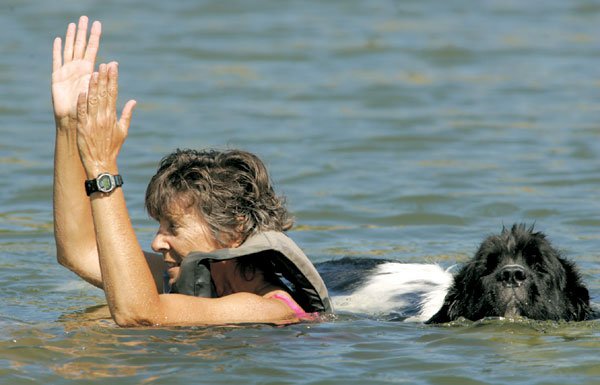MORGAN HILL
– Treading the water of Uvas Reservoir, Dominik Kacprzak
clutched his hands along the back of Yogi, his 110-pound
Newfoundland. The dog paddled heartily toward shore, ”rescuing”
Kacprzak in a water test held Saturday morning.
MORGAN HILL – Treading the water of Uvas Reservoir, Dominik Kacprzak clutched his hands along the back of Yogi, his 110-pound Newfoundland. The dog paddled heartily toward shore, ”rescuing” Kacprzak in a water test held Saturday morning.
As Yogi and his handler strolled out of the reservoir, a judge announced on the public address system: ”That’s a pass!” The crowd of about 50 of spectators broke into applause and shouted enthusiastically for Yogi’s moment of triumph.
The 10-month-old ”Newfie” vigorously shook water from his thick black coat. A chain of slobber hung from his canine smile. Yogi had just aced his final exam of the Newfoundland Club of Northern California, qualifying him for the junior title of ”water dog.”
Every July, the club uses Uvas Reservoir for its annual early summer series of water rescue tests, said Pam Rubio, a Gilroy resident who chairs the regional club’s test board of directors.
Twenty dogs were entered for junior and senior division exercises on Saturday, she said.
”We have people coming up from the San Diego area and the Portland area,” she said. ”A lot of our people are from out of the area.”
Morgan Hill residents Joe and Trish Kidd brought their 7-year-old Newfoundland ”Murphy” to the reservoir to check out the testing procedures as well as to see if they want to join the club. They found their Newfie in an advertisement in the San Jose Mercury News.
”The people who had him (before us) had trained him, but they needed to leave the country,” Trish said.
The family fell in love with the adorable Murphy at first sight, she said. His sedate nature and sweet temperament made him a perfect companion for the Kidd’s children.
Their young son Dylan, who weighs 80 pounds, is getting strong enough to take the 140-pound Murphy on walks around the neighborhood.
”They can be a little intimidating,” Trish said. ”People see this big dog, and they move to the side. But the dogs are gentle.”
”Chance,” a 3-year-old Newfie owned by Alex Hoops of Hercules, displayed a philosophical face as he surveyed the other dogs at the reservoir parking lot. The 130-pound dog began to sniff Murphy in a doggie way of saying ”Hello.”
Hoops said she always liked the cuddly bear-like look of Newfoundlands and their gentle demeanor.
”He’s really lazy at home,” Hoops said. ”But then when you get him around other dogs, he gets all excited.”
The dogs were bred for working purposes on the island of Newfoundland in eastern Canada, Rubio said. Although it’s uncertain exactly what breed they were derived from (possibly Great Pyrenees), their ancestors were originally brought over by European fishermen
”A Newfoundland is a breed originally bred to help on ships in Newfoundland,” Rubio said. ”It was the British who really brought the breed to recognition. They bred them extensively in England.”
The dogs are admired for their physical strength and are still used in some rural areas Newfoundland to pull carts. Their heavy coat protects them from icy waters and their feet are webbed, giving them added power while swimming.
Although it’s not common to see them as water rescue dogs in the United States, some areas of Europe still use them to patrol public swimming areas along lakes and rivers.
”The dogs have been used historically for rescue,” said John Pearson, chief steward for the club’s Uvas Reservoir exercises. ”They have some instincts that we try to maintain by doing the tests.”
A recent rescue by a Newfoundland dog occurred in California’s Sierra range when a person panning for gold was swept into the river current, he said. A woman happened to be walking her Newfoundland along the shore and the dog jumped into the raging water and pulled the drowning person out.
”That dog had no training,” Pearson said. Sometimes Newfoundlands might see a person playing in a lake or river and instinctively try to ”rescue” them even if there is no danger, he said.
Kacprzak said he was surprised Yogi passed all his tests on the first try. Often, puppy Newfoundlands need a few attempts. But he attributed Yogi’s success to a ”home-team advantage.” Kacprzak often drove from his home in South San Jose to Uvas Reservoir to train Yogi on water rescue.
”He really likes water,” he said. ”He catches on really fast.”















